Choosing the Perfect Outdoor Chairs and Umbrella Set
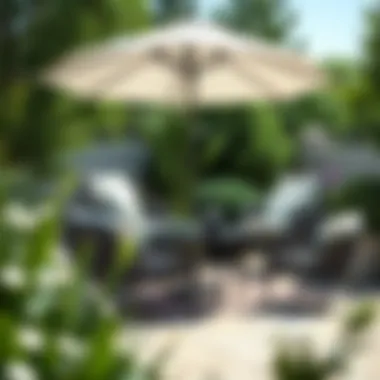
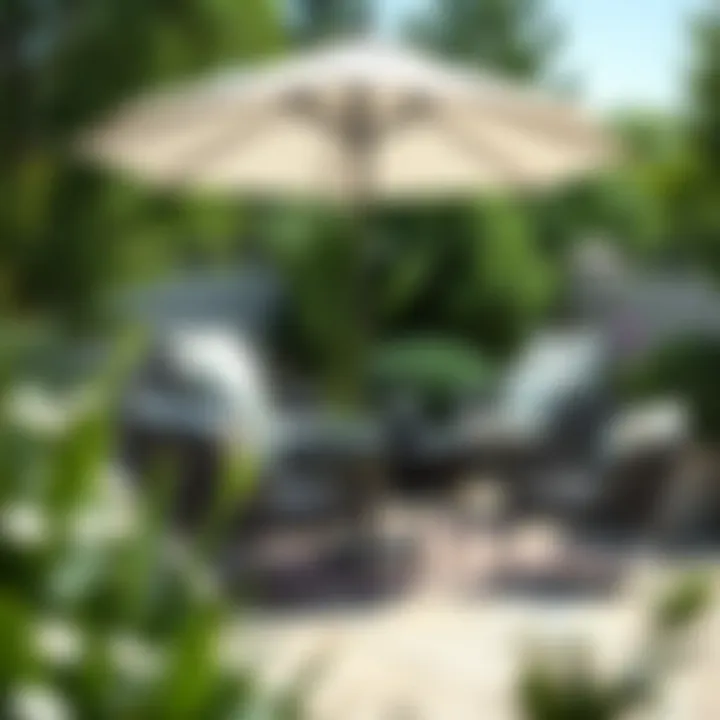
Intro
The outdoors can be a breath of fresh air when it comes to relaxation and social gatherings. Selecting the right outdoor chairs and umbrella sets that complement your table can be a transformative experience for your patio or garden area. This guide dives into the nuances of choosing thoughtful furniture that marries style with utility, essentially crafting a retreat right in your own backyard.
We'll explore trending furniture designs, practical tips on sizes and maintenance, and even delve into the materials that best suit various climates. So, fasten your seatbelt—or rather, your umbrella, as we embark on this comprehensive exploration!
Furniture Design Trends
Designing your outdoor space is not just about functionality; it’s also about creating an environment that feels like an extension of your home.
Current Styles and Themes
Outdoor furniture trends have evolved remarkably. From sleek minimalism to rustic charm, there’s a myriad of styles to consider. Bright, bold colors are standing out—think vibrant yellows and earthy greens. These can inject life into any dreary space. On the flip side, muted hues like soft gray and beige are also making waves, offering a more serene ambiance.
Some popular themes include:
- Coastal Vibes: Light woods and weather-resistant materials paired with blue accents.
- Modern Minimalist: Clean lines, geometric shapes, and monochromatic colors that keep things simple.
- Bohemian Chic: Mix and match patterns and vibrant colors that create a laid-back, eclectic feel.
Color Palettes and Materials
Choosing the right color can improve the overall vibe of your outdoor furniture. Think of it as dressing your outdoor area for a summer party. Natural materials like teak or eucalyptus wood are gaining traction for their durability and timeless appeal. This is particularly crucial if your furniture will be exposed to the elements.
On the flip side, synthetic materials like resin wicker are also popular for their resistance to fading and corrosion. When it comes to cushions, opt for fade-resistant fabrics that can withstand both sun and rain.
"Your outdoor space is like a canvas; the right colors and materials create the masterpiece."
Practical Furniture Tips
The charm of outdoor furniture is not just in its aesthetic, but also in its practical usage. Understanding how to select the right items can make or break your outdoor experience.
How to Choose the Right Size
When selecting furniture, consider the dimensions of your space. Each piece should suit the size of your patio or garden. A large table surrounded by oversized chairs might overwhelm a small area. Compounding this is the necessity to leave ample walking paths. As a rule of thumb, ensure at least two feet of space for ease of movement around tables.
Maintenance and Care for Longevity
Taking care of your outdoor furniture is akin to nurturing a relationship—without maintenance, things can fall apart. Regular cleaning and, if necessary, applying sealants can significantly extend the lifespan of your pieces. For wooden furniture, annual treatment with oil or varnish helps to retain its look and feel.
In contrast, for metal bases, keep an eye out for rust and wipe it down periodically. Cushions should be removed during bad weather or stored properly when not in use to help with longevity.
By focusing on these areas, homeowners can create inviting, functional outdoor spaces that are both delightful to a sit in and easy to maintain.
Preamble to Outdoor Furniture
In recent years, the focus on outdoor living has grown significantly. That’s not just a trend; it’s an evolving lifestyle choice many homeowners are tapping into. Outdoor furniture goes beyond mere utility—we are talking about crafting environments where people can relax, entertain, or even dine al fresco. The importance of outdoor seating, paired with thoughtful design up to the inclusion of chairs, tables, and umbrellas, can transform a backyard into a welcoming retreat.
The Importance of Outdoor Seating
Outdoor seating serves a dual purpose. It provides comfort and function, making outdoor spaces not just an extension of our homes but vital areas for gathering and engagement. Think about it: what's the point of spending time outside if there's nowhere comfortable to sit? Chairs, benches, and loungers invite us to slow down, have a conversation, or enjoy a book under the sun. This aspect is particularly crucial during warmer months when families and friends gather more frequently.
Moreover, quality outdoor seating can improve the aesthetic of a patio or garden significantly. From contemporary metal designs to classic wooden options, your choice in furniture speaks volumes about personal style and taste. It encourages functionality while enhancing the visual appeal of one's outdoor space.
Emphasizing Comfort and Utility
When selecting outdoor chairs, comfort should take precedence. No one wants to sit on a hard surface when they could be lounging in plush, supportive seats. Take a moment to consider how often your family and friends will use these pieces.
Key considerations include:
- Cushioning: Look for chairs that offer removable and weather-resistant cushions. This makes maintenance easier and ensures comfort.
- Ergonomic Design: Seating that supports the natural curves of the body allows for longer, more enjoyable hours spent outdoors.
- Mobility: Foldable or stackable models can be quite useful in a dataset of varied seating arrangements.
However, utility doesn’t end at just comfort. Many outdoor chair options come with integrated features that enhance their function. For instance, some models are designed to be lightweight but sturdy, making them easy to rearrange as needed, while others may include built-in tables for drinks or snacks.
Outdoor furniture can be a worthy investment, significantly increasing not just the appeal but also the utility of your exterior spaces. The right choices lead to memorable moments with loved ones, all while complementing the natural beauty surrounding your home.
Evaluating Outdoor Chairs
When it comes to enhancing your outdoor living space, outdoor chairs play a pivotal role. They don’t just serve as seats; they enhance comfort, style, and functionality in your patio or garden area. Evaluating outdoor chairs carefully can lead you to the perfect fit for your needs, making a considerable difference between a simple outdoor setup and an inviting haven.
Types of Outdoor Chairs
Foldable Chairs
Foldable chairs are precisely what the name implies—chairs that can be folded and stored away easily. This type of chair is ideal especially for those who enjoy flexibility in their outdoor arrangements. You can deploy them when needed, and stash them away when they’re not, making it a crowd favorite amongst those with limited space. The ease of transport is another feather in its cap; whether you’re heading to a picnic or just rearranging your garden, foldable chairs glide right along with you. However, keep in mind they may lack the strength of sturdier models in windy conditions.
Reclining Chairs
Reclining chairs offer a level of relaxation that other outdoor seating options simply can't match. These are designed to allow users to kick back and adjust their position, transforming a regular chair into a comfy lounge experience. The unique feature of reclining chairs is their adjustable backrest, which is perfect for sunbathing or simply enjoying a book in your backyard. However, some might find the mechanisms that adjust these chairs sometimes prone to wear over time.
Stackable Models
Stackable models are the epitome of practicality. These chairs allow you to save space in tiered stacks, making them ideal for gatherings where extra seating might be something you need on occasion. Their lightweight design combined with the ability to easily stack makes them a popular choice for homeowners looking to keep things tidy. However, stacking can sometimes lead to scratches or scrapes on the surface if not done carefully.
Material Selection


Metal Options
Choosing metal options for outdoor chairs is about durability and a contemporary feel. Metal chairs can withstand weather's styles without flinching, and their resilience against rust is a significant plus—especially when you live in areas prone to inclement conditions. Moreover, designs can range from sleek modern aesthetics to more classic options. However, during hot days, metal chairs can heat up, making it less comfortable without cushions.
Wood Variants
Wood variants are timeless choices, exuding warmth and natural beauty that complements outdoor space effortlessly. Their charm lies in the beautiful grain patterns and variations that come with wood, making each piece unique. However, it's important to consider treatments and sealants that can prolong their life. Like any natural product, wood needs care and is vulnerable to outdoor conditions, which can warp or fade over time without proper attention.
Synthetic Materials
Synthetic materials have become a powerhouse in outdoor furniture, with polycarbonate and resin options taking center stage. These materials are incredibly durable, easy to clean, and resistant to the elements, which means they can last for years without fading or cracking. The unique feature of synthetic furniture is that it often mimics the appearance of wood or metal while offering lightweight advantages. On the downside, some may find synthetic options less appealing in terms of feel compared to their natural counterparts.
Design Considerations
Style Trends
When we dive into style trends for outdoor chairs, we see a shift towards modern, minimalist designs that integrate seamlessly with nature. Clean lines and understated elegance often make their way into contemporary outdoor spaces. Adopting these trends isn’t just about aesthetics; it also reflects a lifestyle choice that values simplicity and comfort. One downside, though, is that popular styles can sometimes lead to a lack of uniqueness for your personal touch.
Functional Features
While style does matter, functional features can elevate an outdoor chair from basic to standout. Look for models that offer extras—like built-in shade, weather-proof fabrics, or even compartments for storage. Such features can enhance convenience, making your time outdoors more enjoyable. However, the more features there are, the more intricate the chair design might be, which could affect mobility and storage.
Color Palettes
Color palettes can be a game changer in outdoor settings. They can set the mood, reflect personality, and provide a stunning contrast against the greenery. Bright colors might lend a lively vibe, while muted tones could offer peace and elegance. One key consideration is how colors blend with other furniture and the surrounding nature—they should complement rather than clash. Nevertheless, vibrant colors might fade with prolonged sun exposure, requiring regular upkeep or replacements.
The Role of Umbrellas in Outdoor Spaces
When it comes to enhancing outdoor living environments, umbrellas play a critical role that often goes unnoticed. Not just mere shade providers, they are integral to crafting comfortable and functional outdoor spaces. Their importance is particularly pronounced in areas where sun exposure can quickly turn an enjoyable day outside into a regrettable experience of sunburn or discomfort. An umbrella isn’t only about escaping the sun; it creates a cohesive look, providing a visual anchor amidst the outdoor elements.
Types of Outdoor Umbrellas
Different types of outdoor umbrellas cater to varying needs and preferences, allowing homeowners to find options that best fit their style and functional requirements. Here’s a closer look.
Market Umbrellas
Market umbrellas stand out for their size and versatility. Typically used in commercial settings, they are now a popular choice for residential backyards and patios. Their defining characteristic is a large, broad canopy that provides substantial coverage.
One significant advantage of market umbrellas is their ability to shade entire dining or lounge areas, making them a go-to for gatherings and larger outdoor setups. However, their size can be both a blessing and a curse; while they offer extensive shade, they may also require considerable space to deploy effectively.
Cantilever Umbrellas
Cantilever umbrellas bring a unique twist to outdoor shading. Unlike traditional umbrellas, they feature an offset design that positions the pole away from the seating area. This allows for unobstructed space beneath the umbrella, making it a favorable option for dining tables or lounge chairs.
The key advantage of cantilever umbrellas is their flexibility in adjusting the angle of the canopy, allowing for optimum sun coverage throughout the day. However, this design often comes with a higher price tag and can be less stable compared to other types unless properly anchored.
Table Umbrellas
Table umbrellas are designed specifically to fit through a patio table’s center hole, providing targeted shade right where it’s needed. Their key characteristic is the smaller size compared to market or cantilever umbrellas, making them perfect for intimate settings like bistro tables or garden benches.
A notable advantage lies in their compact nature; they do not demand much space and are easy to set up and dismantle. However, the limited diameter of the canopy means they might not provide adequate coverage for larger areas or multiple seating arrangements.
Functionality and Protection
When choosing an umbrella, functionality is paramount. Different features contribute distinct protective benefits for outdoor spaces.
UV Protection
One of the standout features of quality umbrellas is UV protection. Not all umbrellas are created equal in this regard; many higher-end models offer fabrics treated to reflect harmful ultraviolet rays. The primary advantage of UV protection is the comfort it brings, enabling outdoor relaxation without the persistent worry of sunburn. Furthermore, not only does it protect skin, but it also safeguards underlying furniture from fading. However, it's essential to check the UV rating of the umbrella fabric; products vary significantly in performance.
Wind Resistance
Wind resistance is another crucial aspect of outdoor umbrellas. Given their large surface area, umbrrellas can act like sails when the wind picks up. Many models come with features like reinforced frames and cantilevered designs to combat this. Selecting a well-designed umbrella is vital; it should withstand gusts without toppling over. But even a robust umbrella has limits concerning wind speed, so it's best to consider your local weather patterns.
Ease of Use
Ease of use is a non-negotiable quality in outdoor umbrellas. Some come with automatic open mechanisms or crank systems that make setup a breeze. The key characteristic of user-friendly umbrellas is accessibility—making the act of shading your space straightforward and quick. This adds convenience for impromptu gatherings or leisurely afternoons where you might be combining multiple tasks. However, it’s crucial to balance ease of use with durability; flimsy mechanisms might fail after a few seasons.
Aesthetic Contributions
Outdoor umbrellas are not just functional but also enhance the overall aesthetic of a space.
Color Coordination
Effective color coordination can elevate the appeal of an outdoor setting. An umbrella that complements the furniture or surrounding landscape can create a cohesive and appealing look. Vibrant hues can energize a space, while muted tones offer a calming effect. The rich variety available allows homeowners to express their personality through selections that resonate with their style. Yet, it can be tricky; choosing colors requires consideration of fading over time and the umbrella's ability to blend with changing seasonal décor.
Patterns and Textures
Introducing patterns and textures into an outdoor space through umbrellas can leave a lasting impression. Striped or floral prints can provide dynamism, while solid colors can evoke serenity and calm. Textured fabrics contribute an additional layer of depth to the area, enhancing overall enjoyment. While this adds charm, finding the right balance is essential to avoid overwhelming the space. Too many bold patterns can clash and turn a serene setting into chaotic confusion.
Complementing Furniture
Lastly, complementing furniture is vital for creating a harmonious outdoor environment. An umbrella that matches or contrasts with the patio set can tie the whole area together. It’s all about creating balance; too many colors or styles might disrupt the visual flow, while complementary pieces work to spotlight each other. This thoughtful approach fosters a space that invites relaxation and dining in equal measure, though it does take some planning to ensure all elements align aesthetically.
"Choosing the right outdoor umbrella is more than just a decision based on shade; it's about curating an inviting outdoor experience."
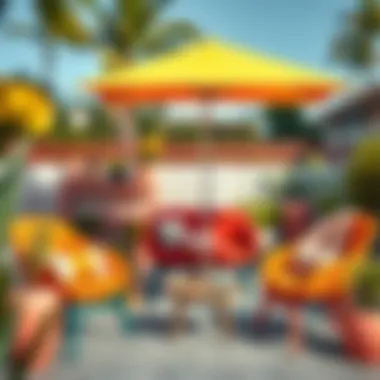
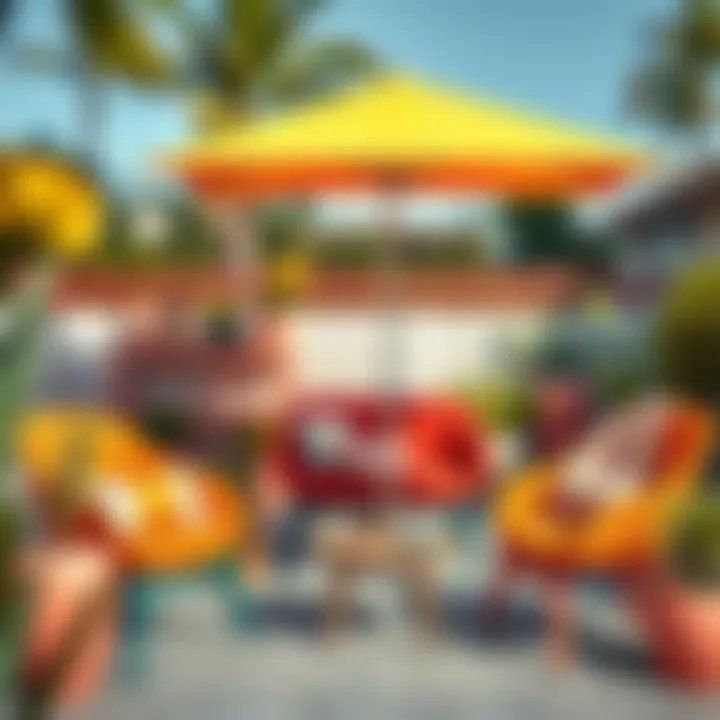
By evaluating the type of umbrella along with their aesthetic and functional elements, homeowners can greatly improve the usability of their outdoor spaces. The right choice can transform an ordinary garden into an inviting haven.
Choosing the Right Table
When it comes to creating a harmonious outdoor space, selecting the right table plays a pivotal role. Tables are not just surfaces to hold your refreshments; they serve as a focal point, drawing people together. They are crucial for setting the stage for conversations, meals, and relaxation. Thus, understanding the various types of tables, their functions, size considerations, and material durability can vastly improve the utility and aesthetics of your outdoor area.
Table Types and Their Functions
Dining Tables
Dining tables stand out as prominent features of outdoor settings. They facilitate pleasurable meals al fresco and bring family and friends together. The best characteristic of these tables is their size—often larger, they can accommodate multiple diners comfortably. This makes dining tables a popular choice for gatherings and celebrations. A unique aspect of dining tables is their versatility; they can be crafted from various materials, enhancing their appeal. However, one must consider that larger tables can take up substantial space, meaning they are not always ideal for compact patios.
Coffee Tables
Coffee tables serve a different purpose in outdoor settings, often acting as a casual gathering spot for drinks and light snacks. Their key characteristic is their lower height, making them a relaxed option for lounging around with friends or family. Moreover, coffee tables can add an aesthetic element to the space, often serving as decorative pieces with unique designs or materials. However, their smaller size means they may not be suitable for full meals, limiting their functionality compared to dining tables.
Side Tables
Side tables are unsung heroes in outdoor furniture environments. They provide convenience without overwhelming the space. Their primary advantage is a compact design, allowing them to fit in smaller areas while being functional. They are perfect for holding drinks, books, or other small items within reach of lounge chairs or sofas. However, because they lack the larger surface area of dining or coffee tables, they may not be sufficient for bigger dinners or gatherings.
Size and Proportions
Dimensions for Compact Spaces
For those with limited outdoor space, opting for tables with compact dimensions is essential. Smaller tables can easily fit into tight corners or balconies without sacrificing style. The key characteristic here is efficiency; a well-chosen compact table can still serve multiple functions without feeling cramped. However, they might struggle to accommodate guests during larger gatherings, a potential downside for certain homeowners.
Large Gatherings
On the other end of the spectrum are tables designed for larger gatherings. These expansive tables allow guests to sit comfortably while enjoying a meal together. The highlight of these tables is their ability to foster a sense of community, making them ideal for parties or family get-togethers. Nonetheless, they require ample space, which may not be feasible for every yard or patio setup.
Multi-Use Tables
Multi-use tables provide flexible options that can adapt to various needs. Designed to serve different functions, they may transition from a dining table during meals to a coffee table when entertaining. This adaptability makes them particularly beneficial for those who want to maximize their outdoor experience. Considering the size, they may not offer the same level of comfort during extensive dining or lounging but excel in versatility, fitting seamlessly into different types of gatherings.
Material Influence on Durability
Wood Versus Metal
When considering material for tables, the debate typically revolves around wood and metal. Wooden tables often evoke warmth and natural beauty, becoming a centerpiece in any outdoor setting. However, they require regular maintenance to prevent rot and weathering. On the flip side, metal tables offer durability and a modern look, often proving to be less demanding in terms of upkeep. Balancing aesthetics and practicality can be a challenge for many homeowners.
Glass Surface Options
Glass tops are another consideration for outdoor tables. They add a touch of elegance and can make spaces feel more open. The smooth surface is easy to clean but carries the risk of breakage or shattering. Homeowners must weigh the visual appeal against the safety concerns and durability of glass, especially in areas with children or prone to harsh weather.
Composite Materials
Composite materials have gained traction in the furniture world. These tables are designed to withstand the elements while providing the aesthetic quality of wood. They combine durability with a range of designs, making them a great choice for outdoor settings. However, some may find them less traditional and lacking the rustic character of natural wood.
Styling Outdoor Furniture Sets
When it comes to creating an inviting and enjoyable outdoor space, the art of styling your furniture set cannot be overemphasized. It's more than just plopping down a chair and table; it’s about crafting an environment that is cohesive, functional, and visually appealing. A well-styled outdoor furniture set enhances your experience, making it a lovely extension of your home, suitable for family gatherings, or leisurely afternoons with a good book.
Creating Cohesive Looks
A cohesive look is essential in outdoor spaces, as it ties together various elements harmoniously. When styling an outdoor setting, consider a consistent color palette that can echo through your seating, table, and decor. Simple patterns can say a lot—think of striped cushions or patterned throw pillows that bring a splash of life to your arrangement. Also, choosing furniture styles that complement each other, whether modern or rustic, can create a pleasing overall look. Rediscovering pieces you already own and blending them with new additions often yields surprise results that are not only creative but wallet-friendly too.
Using Accessories for Enhancement
Cushions and Throws
Cushions and throws are not just about comfort; they serve as vibrantly colored accents that can elevate the look of your outdoor chairs and sofas. Selecting cushions with weather-resistant fabric means they’ll last longer while feeling soft against your skin. Pillows can often come in different shapes—some might prefer square, while others go for the classic rectangle. Throw blankets can introduce texture and warmth, perfect for chilly evenings. The key characteristic of cushions is their versatility; they can be switched out seasonally, allowing for fresh designs without substantial investment. Colorful patterns can easily transform a dull setting into a lively tableau, making cushions an indispensable part of your outdoor styling toolkit.
Centerpieces and Decor
Centerpieces and decor pieces have an amazing capacity to draw people together. A table centerpiece, such as a vibrant flower arrangement or an elegant candle display, can enhance the atmosphere significantly. It’s vital, though, that such decor reflects your personal style while being practical and easy to maintain. Adding decorative elements can break up monotony, especially with layered textures and contrasting heights. Unique centerpieces provide not only visual interest but serve as conversation starters. However, avoid overcrowding the table; a well-chosen centerpiece can definitely make a statement.
Outdoor Lighting
In terms of creating ambiance, outdoor lighting is a game changer. String lights, lanterns, or solar-powered garden lights can help set the mood when dusk settles. The benefit of outdoor lighting goes beyond beautification; it extends evening gatherings, ensuring you can entertain or relax well after the sun goes down. A strategic placement of lights guarantees access to safety and enhances the beauty of the space. Yet, while lighting adds allure, it also requires careful thought regarding energy efficiency—opt for LED options for longevity and lower electricity costs.
Seasonal Adjustments
Seasonal adjustments to your outdoor setup can breathe new life into your space as weather changes. Embracing different styles, colors, and arrangements can keep things fresh year-round, enhancing the appeal of your outdoor area.
Spring and Summer Styles
During spring and summer, the emphasis is on light and airy styles. Bright colors and floral prints can dominate your outdoor decor, coinciding with the vibrant blooms of the season. Lightweight materials and breathable fabrics ensure comfort even during the hottest days. The ease of upkeep is another admirable feature of these styles; quick spot cleaning or the occasional wash can keep them looking their best when outdoor entertaining is in full swing.
Autumn Arrangements
As leaves change color and temperatures cool, autumn arrangements often shift toward earthy tones. Deep oranges, browns, and warm reds can create a cozy atmosphere, evoking feelings of warmth as one transitions back to indoor living. In addition, incorporating decorative pumpkins or gourds can enhance your autumn theme significantly, creating a rich, seasonal feel to your outdoor setting.
Winter Protections
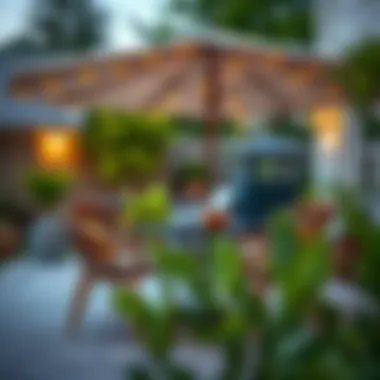
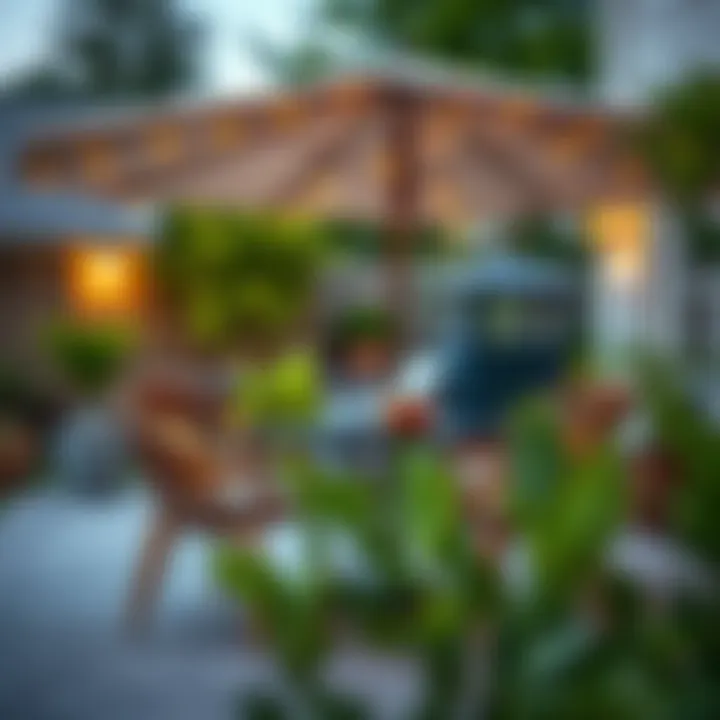
Winter can be quite harsh on outdoor furniture, making protective measures crucial for maintaining the condition of your setup. Consider investing in quality covers that can shield your pieces from snow and ice while ensuring durability. Even the most weather-resistant materials can fall prey to harsh winter elements without the right care. Give thought to employing reflective surfaces or strategically placed heaters to extend your outdoor use into the chillier months. A well-planned winter protection strategy allows you to cherish your outdoor space all year long.
In Summary: Styling your outdoor furniture sets is vital for creating a welcoming area that reflects your personal tastes while Ensuring comfort and functionality. Think about cohesive looks, utilize accessories with intention, and make seasonal adaptations to keep your outdoor space dynamic and enjoyable.
Maintenance of Outdoor Furniture
Maintaining outdoor furniture is not just about keeping it looking good; it’s about prolonging its life and ensuring it remains functional and safe for use. Many homeowners invest considerable time and resources into selecting quality outdoor furniture. However, neglecting proper maintenance can lead to premature wear and tear. Regular upkeep helps to protect against the variety of elements that outdoor environments throw at our furniture, from sunlight and rain to humidity and temperature fluctuations.
By implementing diligent maintenance practices, you can safeguard your investment and continue enjoying your outdoor space for years to come. Investing a little time and effort up front will save you from bigger hassles down the line, ensuring your outdoor chairs, umbrellas, and tables retain their appeal and comfort.
Cleaning Techniques for Various Materials
Cleaning outdoor furniture isn't a one-size-fits-all job. Different materials demand specific care methods:
- Wood: Use a soft brush and a mixture of soap and water to gently scrub. Avoid power-washing as it can damage the finish. Regularly apply a wood protectant to shield against moisture and sun exposure.
- Metal: Alloy or aluminum pieces can be wiped down with a cloth soaked in soapy water. If rust appears, a light sanding followed by a rust-inhibiting spray will do wonders. Keep a can of spray paint handy for touch-ups on chipped spots.
- Plastic: This versatile material often collects dirt and algae. A mixture of vinegar and water can be effective. For tougher stains, a diluted bleach solution may work well, though be cautious not to use too much as it can dull the finish.
Regular cleaning not only enhances the look of your furniture but also prevents the build-up of grime which can lead to longer-lasting damage.
Preventive Care Strategies
Regular maintenance is all well and good, but preventive strategies can often save you time and effort:
- Covers: Investing in quality covers can protect your furniture from the elements. Even a lightweight tarp can do the trick during off-seasons.
- Sealers and Treatments: For wooden items, applying seals or oils can drastically improve resilience against moisture absorption and UV ray degradation. For metal, these treatments help prevent rusting.
- Rotation: If your setup allows it, rotating your furniture periodically can help it weather more evenly. This is particularly helpful in shade vs. sun exposure areas.
These simple strategies go a long way in keeping your outdoor furniture looking pristine, reducing the frequency of deep cleaning processes.
Storage Considerations
When the weather starts turning cold or rainy, storage becomes an important aspect of furniture maintenance. Taking the time to store your chairs, tables, and umbrellas correctly can extend their lifespan significantly.
- Indoor Storage: If space allows, bringing items indoors during harsh weather is preferable. Furniture can degrade quickly if consistently exposed to the elements.
- Stacking: For chairs that allow for stacking, this can save space and protect fabric or painted surfaces from scratching. When stacking, place a cloth between items to prevent contact marks.
- Off-Season Organization: Use a designated area for your patio items, keeping things organized so that you can easily retrieve them when needed again in the spring.
Remember, "an ounce of prevention is worth a pound of cure." Proper storage isn't a tedious task—it's an investment in maintaining beauty and functionality.
By implementing a routine and utilizing the right techniques, the outdoor furniture you love can bring joy and relaxation for years to come. Regular care doesn’t just preserve furniture; it enhances the entire outdoor experience.
Maximizing Outdoor Space Utilization
When it comes to outdoor living, the way you utilize your space can spell the difference between a cozy retreat and a chaotic patch of grass. Maximizing outdoor space utilization means not just fitting in furniture but doing so in a way that enhances both the function and the aesthetic of your area. It's about creating an outdoor haven where beauty meets practicality. Homeowners who invest time into understanding how to utilize their outdoor spaces will find that they not only enjoy their surroundings more, but they also elevate their property’s value.
Layout and Design Principles
A well-thought-out layout can transform any patio, garden, or balcony into a functional oasis. The first step is to consider the dimensions of your space. When laying out outdoor chairs, umbrella sets, and tables, avoid haphazard placement. Instead:
- Define Areas: Consider creating separate zones for dining, lounging, and socializing. This gives each section a purpose and allows for better flow.
- Balance: Don't overcrowd your area. Leaving some spaces open creates a pleasant, airy feel. You might want to use large umbrellas to delineate spaces instead of imposing partitions.
- Orientation: Think about the sun's movement. Position your umbrella sets and tables to maximize shade during peak sunlight hours, making your outdoor space more inviting.
Implementing these principles leads to the greatest use of space without compromising comfort. A well-planned layout encourages you to spend more time outdoors, enjoying the fresh air and sunlight.
Function Zones in Outdoor Areas
Creating function zones helps establish a sense of purpose and organization. Think of your outdoor area as a room without walls where each piece of furniture plays a key role. Here are important zones to consider:
- Dining Zone: Arrange your dining table and chairs away from heavy foot traffic, allowing for ease when serving and accessing meals. Setting an outdoor dining table close to the kitchen makes serving food much more convenient.
- Lounge Zone: This area should be inviting, with comfortable chairs and appropriate shade for relaxation. It’s here that you might want to throw in some cushions and decor.
- Cooking Zone: If you're into grilling, have a specific area designated for barbeques. If space allows, keep the grill away from the dining table to minimize smoke and disruption.
- Activity Zone: If you have kids or enjoy activities like yoga, allocate a small open area for these purposes. It can be a small section with a rug or mats laid out.
Designing function zones encourages you to think about how you engage with your outdoor space. Each area can cater to different activities, ensuring that everyone finds a place that suits their needs and mood.
Accessibility and Flow
Accessibility is crucial when maximizing outdoor space. You want to create a layout that allows easy movement without any obstacles hindering your enjoyment:
- Paths and Walkways: Use pavers or stepping stones to create clear paths. This not only guides movements but keeps foot traffic from trampling your grass or flower beds.
- Furniture Placement: Make sure your chairs and tables are not blocking access points. Keeping the walkway free ensures that everyone can easily move between zones without hassle.
- Open Space: Open spaces make the outdoors feel less cramped. Designers often suggest leaving space between pieces of furniture to create a natural flow, such as a path leading from the table to the lounge area.
With attention to accessibility, you’re not just arranging furniture; you’re shaping an experience that allows for genuine enjoyment of your outdoor retreat.
"Optimal use of outdoor space creates an environment for relaxation, connection, and enjoyment."
By applying these principles of maximizing outdoor space utilization, you're not merely placing furniture in an outdoor setting; you're crafting an experience that invites relaxation and engagement with nature. This comprehensive understanding ensures that your outdoor spaces function as extensions of your living areas.
The End: Crafting Your Outdoor Haven
In the journey of crafting your outdoor haven, the importance of choosing the right outdoor furniture cannot be overstated. This article has guided you through the various facets of outdoor chairs, umbrellas, and tables, emphasizing that these elements go beyond mere aesthetics. They are about creating comfort, maximizing space, and enhancing functionality. When selections are made with care, they can transform your outdoor areas into extensions of your home.
A well-thought-out outdoor setup can foster relaxation and socialization, allowing you and your loved ones to enjoy the fresh air. The correct mix of chairs, umbrella sets, and tables not only creates an inviting atmosphere but also ensures that every occasion is a pleasure—be it a quiet morning coffee or a lively dinner party under the stars.
"Choosing furniture is not just about style; it’s about crafting memories under the open sky."
Final Thoughts on Selection
As you reflect on your selection process, it’s crucial to consider various practical aspects. Durability should top the list—after all, outdoor furniture must withstand the elements while still looking good as new. Materials like aluminum, teak, or synthetic resin prove their worth over time, standing firm against sun, rain, and wind. Additionally, pay attention to the size and scale of your pieces in relation to your space. Compact arrangements can maximize functionality without overwhelming your outdoor area. Also, incorporating a blend of styles can reflect your individual taste.
Key Tips for Selection:
- Durability: Consider the climate and select materials that can endure it.
- Size: Ensure furniture scales well with your space to allow ease of movement.
- Style: Mix and match styles for a personalized touch that speaks to your home’s character.
Importance of Personal Touch
When crafting your outdoor haven, the personal touch is what truly brings the space to life. It is easy to get lost in trends and materials but remember that your outdoor area should tell a story—your story. Accessories such as colorful cushions, unique planters, or quirky table settings can breathe life into your outdoor setup. It’s appropriate to curate your space in a way that makes it distinctly yours.
Adding personal elements invites a deeper connection. Consider how you want to feel in this space and what memories you wish to create there. Family barbecues, relaxation with a good book, or intimate gatherings can all be enhanced with touches that echo your preferences.
In summary, as you build your outdoor haven, be mindful of both selection and personal expression. A well-balanced combination of functionality, design, and individual flair will ensure that your outdoor spaces become cherished retreats, serving as an oasis of style and comfort for years to come.



